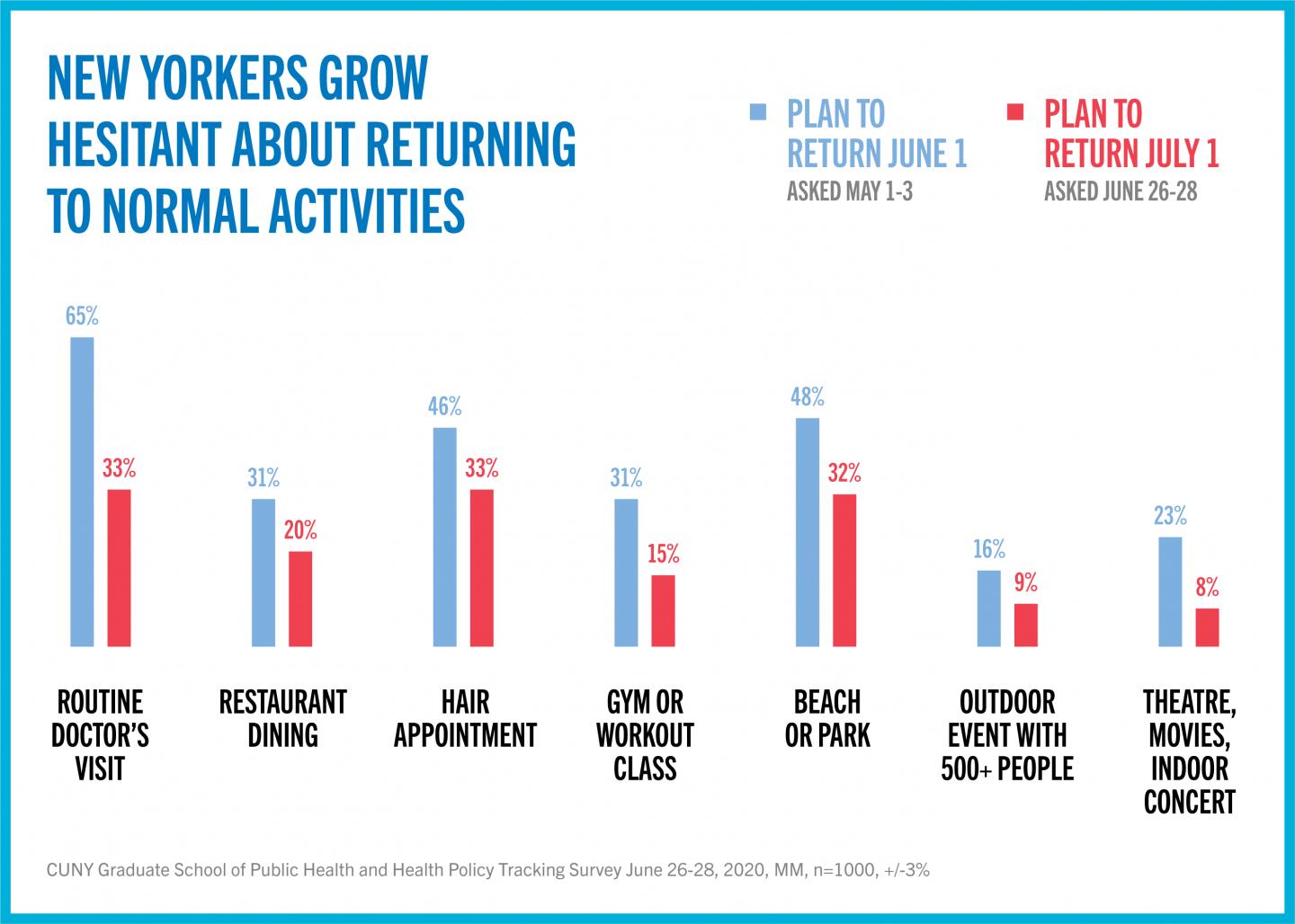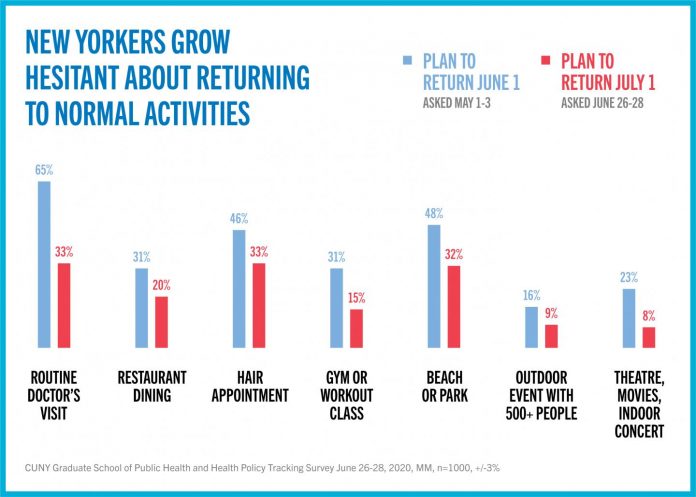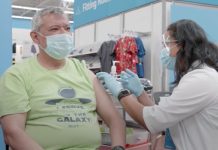
IMAGE: As May 2020 began, 65% of New Yorkers said they would see their doctor for a routine visit beginning at the start of the next month. In June, that number…
view more
Credit: CUNY SPH
New Yorkers continue to report much higher than normal rates of depression and anxiety, but much less than at their peak in mid-April. As they witness the surge in COVID-19 cases in states that re-opened early, New Yorkers have also grown significantly more hesitant about resuming normal activities than they reported in May. Employment and housing worries remain a serious concern for many. These are the major findings of the 13th city and statewide tracking survey from the CUNY Graduate School of Public Health and Health Policy (CUNY SPH), June 26-28.
As May 2020 began, 65% of New Yorkers said they would see their doctor for a routine visit beginning at the start of the next month. In June, that number dropped to 33%. In early May, 46% said they would go for a haircut starting June 1, but by the end of June, only 33% said they would do so as of July 1. The number who thought they would go to a restaurant after the first of the following month dropped from 31% to 20%. Moreover, a far greater number of respondents now say they plan to wait for a safe and effective vaccine to be widely available before they take part in many routine activities. In May, for example, 31% said they would wait for a vaccine before going to an outdoor concert; in June, nearly twice that number (60%) said they would wait for a vaccine.
Less than a third of respondents believe that public schools (27%) and colleges and universities (31%) should reopen for regular classes in the fall. A majority (54%) do not think the pandemic will end until a vaccine is created.
“People follow the news,” said Dr. Ayman El-Mohandes, Dean of CUNY SPH. “COVID-19 is under better control in New York now, but people see that it is devastating other cities, states and countries, and they do not want to let their guard down. People here also seem to have become resigned to COVID-19. They don’t see the pandemic ending within a finite period of time, instead they link its resolution to the availability of a safe and effective vaccine.”
Serious Economic Pressures Continue for Many
Respondents still face serious economic challenges. One in five respondents (20%) who rent their homes said they would not be able to pay their rent this month, while 10% of homeowners said they would not be able to pay their mortgage. This situation remains unchanged since a mid-April CUNY SPH survey, which reported that 23% of respondents were unable to pay their rent, and 11% were unable to pay their mortgage.
Of those facing difficulties with rent or house payments, 51% believe they will be evicted, and 2% said they have already been evicted. The government’s moratorium on evictions in New York expires on July 6, although some limited protections will remain in place through the end of August.
About one-fourth (26%) of respondents said they had lost their job as a consequence of the pandemic, of whom 46% were terminated and 54% were furloughed. Of those who were terminated, only 54% said they had found another job; of those who were furloughed, only 36% have been asked to return to their previous work.
It is not surprising, then, that more New Yorkers see the economy as worsening (44%) rather than improving (28%). Three in ten respondents remain worried about paying for housing (30%) and more than a quarter (26%) are concerned about employment.
SNAP Numbers Fail to Keep Pace with the Reality of Food Insecurity
About one-third (32%) of the current survey’s respondents report receiving food from SNAP or local non-profit organizations, which is virtually unchanged from late April.
“Despite the determined efforts of public programs to improve access to food assistance, it is disturbing that, four months into the epidemic, less than a third of New Yorkers report receiving such help,” said Nicholas Freudenberg, Distinguished Professor of Public Health and Director of the CUNY Urban Food Policy Institute. “This suggests an ongoing gap, as our survey in late May found that 44% of households were experiencing food insecurity. To reduce the high levels of food insecurity that threaten present and future physical and mental health in New York City, public food programs will need to do more to reach those in need.”
Testing on the Rise
Indicative of a more positive trend, a greater proportion of New Yorkers (42%) reported last weekend that either they or a member of their household has been tested for COVID-19 since March, with three-fourths (75%) of those being tested within the last four weeks. Of this group, 31% reported that the test had been positive, which represents about one in eight (13%) of all the households in the overall survey population. People who reported being tested in previous CUNY SPH surveys were more likely to report testing positive, which suggests that testing was previously being made available only to individuals who appeared to be ill.
Social Issues
About a quarter (26%) of New Yorkers think the coronavirus appears to be a greater threat to the future of the city than racism and police violence (16%). African Americans rated racism slightly higher (20%) and the coronavirus slightly lower (20%) than respondents overall.
However, almost three in five (58%) of all respondents rated the two threats as equal.
Almost three in ten (28%) of respondents said they took part in the recent protests against racism and police brutality, of whom 60% said it was their first time doing so.
Mental Health
Almost half (46%) of respondents report they have not interacted with family and friends outside of their home in the last two weeks, 27% said they have done so once, 21% said two to three times, with 3% reporting four to five times and another 3% reported six times or more.
New Yorkers appear to be habituating to the stress of the pandemic, as mental health symptoms appear to be steadily declining since their peak in mid-April, when mental health risk rates were about 34-44%. Now, only 21% and 28% of New Yorkers are reporting depression and anxiety risks (i.e., experiencing symptoms half of the time in the past two weeks), respectively.
“Increases in social interactions with family and friends, as well as high participation by New Yorkers in social movements, may be buffering the mental health effects of the pandemic,” says Dr. Victoria Ngo, Director of the Center for Innovation in Mental Health at CUNY SPH. “However, only 8% of our latest respondents report that they used free emotional support assistance from city and state resources, like the New York State Office of Mental Health, ThriveNYC, NYCWell, etc. This is worrisome as it suggests that these free resources are not reaching the community.”
Trusted Sources of COVID-19 Information
More than a fourth of New Yorkers reported television news (26%) their most trustworthy source of information about coronavirus, and a similar number (25%) said they trusted the CDC, while 15% said Governor Andrew Cuomo, 10% the WHO, 6% social media, 6% the Trump administration, 5% print news, and 3% family and friends.
The complete survey results and related commentary can be found at https:/
Survey methodology
The CUNY Graduate School of Public Health and Health Policy (CUNY SPH) survey was conducted by Emerson College Polling from June 26-28, 2020 (week 16). This tracking effort started March 13-15 (week 1).
The sample for the NY Statewide and New York City results were both, n=1,000, with a Credibility Interval (CI) similar to a poll’s margin of error (MOE) of +/- 3 percentage points. The data sets were weighted by gender, age, ethnicity, education, and region based on the 2018 1-year American Community Survey model. It is important to remember that subsets based on gender, age, ethnicity, and region carry with them higher margins of error, as the sample size is reduced. In the New York City results, data was collected using an Interactive Voice Response (IVR) system of landlines (n=403), SMS-to-online (n=332), and an online panel provided by MTurk and Survey Monkey (n=232). In the Statewide results, data was collected using an Interactive Voice Response (IVR) system of landlines (n=404), SMS-to-online (n=329) and an online panel provided by MTurk and Survey Monkey (n=267).
In the statewide survey, regions were broken out into the following:
Region 1: Long Island 14.7% (USC1-4), Shirley, Seaford, Glen Cove, Garden City
Region 2: NYC 45.3% (USC 5-16) Queens, Brooklyn, Manhattan, Staten Island, Bronx
Region 3: Upstate 40% (USC 17-27): Albany, Harrison, Carmel, Rhinebeck, Amsterdam, Schuylerville, Utica, Corning, Irondequoit, Buffalo, Rochester
###
The CUNY Graduate School of Public Health and Health Policy (CUNY SPH) is committed to teaching, research, and service that creates a healthier New York City and helps promote equitable, efficient, and evidence-based solutions to pressing health problems facing cities around the world.















